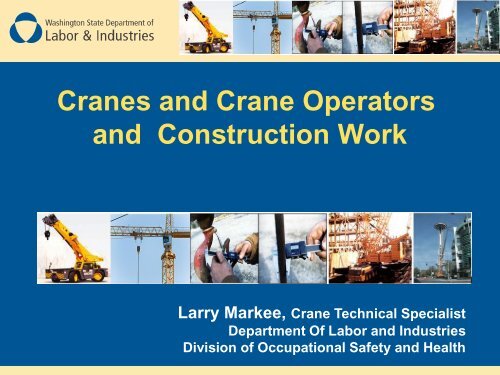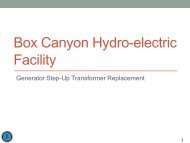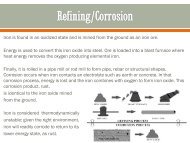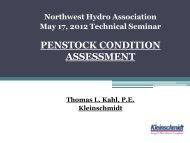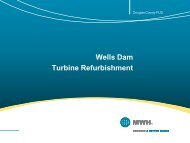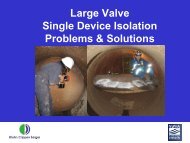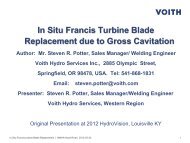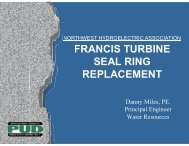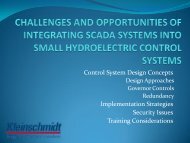Cranes and Crane Operators and Construction Work
Cranes And Crane Operators
Cranes And Crane Operators
- No tags were found...
Create successful ePaper yourself
Turn your PDF publications into a flip-book with our unique Google optimized e-Paper software.
<strong><strong>Crane</strong>s</strong> <strong>and</strong> <strong>Crane</strong> <strong>Operators</strong><br />
<strong>and</strong> <strong>Construction</strong> <strong>Work</strong><br />
Larry Markee, <strong>Crane</strong> Technical Specialist<br />
Department Of Labor <strong>and</strong> Industries<br />
Division of Occupational Safety <strong>and</strong> Health
November 16, 2006
Objectives<br />
• Review Phase One<br />
• Identify where Washington’s current rule could<br />
be impacted by OSHA rule<br />
• Steve’s presentation will contain overview of<br />
OSHA’s new crane <strong>and</strong> derricks st<strong>and</strong>ard<br />
3
The New <strong>Construction</strong> <strong>Crane</strong> Rule<br />
•Phase One:<br />
<strong>Crane</strong> Certification<br />
<strong>Crane</strong> Certifiers<br />
Operator Qualifications January 1, 2010<br />
•Phase Two:<br />
Adopt OSHA’s <strong>Crane</strong> Rule<br />
Address <strong>and</strong> update<br />
Part L of Chapter 296-155<br />
Safety St<strong>and</strong>ards for <strong>Construction</strong> <strong>Work</strong>
Scope<br />
This crane safety rule applies to poweroperated<br />
cranes <strong>and</strong> derricks used in<br />
construction that can hoist, lower <strong>and</strong><br />
horizontally move a suspended load<br />
(with or without attachments).
•Phase one<br />
<strong>Crane</strong> Certification<br />
<strong>Crane</strong> Operator Qualifications<br />
<strong>Crane</strong> Certifier Accreditation
Mobile<br />
<strong><strong>Crane</strong>s</strong><br />
Lattice<br />
Boom<br />
<strong><strong>Crane</strong>s</strong>
Rough-Terrain<br />
<strong><strong>Crane</strong>s</strong><br />
Fixed Cab<br />
Hydraulic <strong><strong>Crane</strong>s</strong>
Articulating Boom <strong><strong>Crane</strong>s</strong><br />
Operator certification
Tower <strong><strong>Crane</strong>s</strong>
Derricks
What’s Excluded ?<br />
The following equipment is exempt from<br />
Annual <strong>Crane</strong> certification<br />
&<br />
Operator Certification
Mechanic’s<br />
truck when<br />
used for<br />
equipment<br />
maintenance<br />
or repair<br />
work<br />
Exempt
Certification Not Required<br />
<strong><strong>Crane</strong>s</strong> with<br />
a maximum<br />
capacity of<br />
one ton or<br />
less.<br />
Service<br />
trucks with<br />
booms that<br />
rotate<br />
manually
Does not fall under the New st<strong>and</strong>ard<br />
Service trucks<br />
(digger derricks)<br />
specifically<br />
designed for power<br />
line work<br />
Note:<br />
This could change
Excavators
Backhoes
Teleh<strong>and</strong>lers / Forklifts
Drilling<br />
Rigs
Machines with booms that<br />
are limited to up & down<br />
movement only <strong>and</strong> does<br />
not rotate<br />
Pump hoists<br />
with booms<br />
that do not<br />
rotate
<strong>Crane</strong> & Operator Certification Not Required<br />
When…..<br />
Used in manufacturing facilities or powerhouses<br />
while used in routine maintenance <strong>and</strong> repair work
Maintenance in Manufacturing<br />
• Maintenance or repair work?<br />
• Occasional or routine?<br />
• Regular, customary, <strong>and</strong> foreseeable work<br />
necessary to keep equipment in good repair?<br />
• If this answer is "yes", then the rule would not<br />
apply.<br />
• If this answer is "no", then the rule would apply.<br />
22
<strong>Crane</strong> Certification<br />
Requirements<br />
•Certification<br />
•Annual Inspection<br />
•Proof Load Test<br />
Mobile<br />
Articulating <strong><strong>Crane</strong>s</strong><br />
**Tower <strong><strong>Crane</strong>s</strong> (annual certification <strong>and</strong> after each<br />
assembly, jumping, etc.)
Certification Requirements<br />
Mobile <strong>Crane</strong> Components<br />
Quadrennial Proof Load Test / Annual<br />
Inspection<br />
<strong>Crane</strong> Components<br />
Boom Sections<br />
Back Mask Sections<br />
Luffing Booms<br />
Jibs <strong>and</strong> Jib Sections
Temporary certificate<br />
of operation.<br />
Accredited crane certifiers will issue a<br />
temporary certificate of operation if upon<br />
inspection <strong>and</strong> load proof testing no<br />
deficiencies were found that would affect the<br />
safe operation of the crane.<br />
WAC 296-155-53114 (1)<br />
A copy of the crane worksheet, completed by<br />
the accredited certifier will act as a temporary<br />
certificate of operation until the annual<br />
certificate of operation is issued by the<br />
Department.<br />
The temporary or annual certificate of<br />
operation must be posted in the operator's cab<br />
or with the operator's manual.<br />
WAC 296-155-53114 (7)
<strong>Crane</strong> / Component<br />
Identification Sticker<br />
7 0 5 4 3 2 1<br />
Sky-High <strong><strong>Crane</strong>s</strong> INC.<br />
Morr-Gra<br />
57 M-G C<br />
04191952 G-M<br />
Sky-High # 42<br />
Boom Tip
Annual<br />
Text/Examination<br />
Certificate<br />
Certificates of operation issued by the<br />
department under the crane<br />
certification program established in<br />
this section are valid for one year from<br />
the effective date of the temporary<br />
operating certificate issued by the<br />
certified crane inspector.<br />
The annual certificate of operation<br />
must be posted in the operator's cab<br />
or with the operator’s manual<br />
WAC 296-155-53114(7)
<strong>Construction</strong> <strong>Crane</strong> <strong>Operators</strong><br />
Qualifications & Requirements
Operator Qualifications & Certification<br />
• The crane operator must:<br />
• Have a valid crane operator certificate, for the<br />
type of crane to be operated, issued by a crane<br />
operator testing organization accredited by a<br />
nationally recognized accrediting agency; <strong>and</strong><br />
• Has crane hours of experience as shown in<br />
Table 1; <strong>and</strong><br />
• Passed a substance abuse test conducted by a<br />
recognized laboratory.<br />
» WAC 296-155-53300(1)(a)
Accredited <strong>Crane</strong> Operator Testing<br />
Organizations<br />
• National Commission for the Certification of<br />
<strong>Crane</strong> <strong>Operators</strong> (NCCCO) http://nccco.org/<br />
• <strong>Crane</strong> Institute of America Certification (CIC)<br />
http://www.craneinstitutecertification.com/<br />
• National Center for <strong>Construction</strong> Education<br />
<strong>and</strong> Research (NCCER) http://www.nccer.org/<br />
• Operating Engineers Certification Program<br />
http://www.iuoe.org/Training/nbsp/tabid/215/Default.aspx
<strong>Crane</strong> Operator Testing Originations<br />
National Commission for the<br />
Certification of <strong>Crane</strong> <strong>Operators</strong><br />
National Center for <strong>Construction</strong><br />
Education <strong>and</strong> Research<br />
<strong>Crane</strong> Institute of America Certification<br />
Operating Engineers Certification<br />
Program.
<strong>Crane</strong> Operator Certification Card
<strong>Crane</strong> Categories <strong>and</strong> Types<br />
• Lattice Boom Truck <strong>Crane</strong><br />
– LBT-<br />
• Lattice Boom Crawler <strong>Crane</strong><br />
– LBC<br />
• Large Telescopic Boom <strong>Crane</strong><br />
– TLL- (Swing Cab)<br />
• Small Telescopic Boom <strong>Crane</strong><br />
– TSS- (Fixed Cab)<br />
• Tower <strong>Crane</strong><br />
– TOW-<br />
• Articulating Boom <strong>Crane</strong><br />
Operator<br />
– ABC ( with hook)<br />
– ABL ( with forks)<br />
– ABW (with winch)<br />
• Overhead <strong>Crane</strong><br />
– OVR-
<strong>Crane</strong> Operator Hours<br />
of Experience<br />
Table 1
Actual Operating Hours<br />
Time while the operator is:<br />
At the controls<br />
Has direct control of the crane<br />
Operating hours within the same crane type<br />
Installing/removing boom sections<br />
Extending <strong>and</strong> retracting outriggers/stabilizers<br />
Leveling crane, <strong>and</strong> replacing hoisting rope
Related <strong>Crane</strong> Experience<br />
•Time as a signalman/bellman, oiler, crane<br />
mechanic, crane inspector<br />
•Formal classroom training, crane<br />
simulator operation, <strong>and</strong><br />
•A combination of operating hours on other<br />
categories of cranes
<strong>Crane</strong> Operator Hours<br />
For crane operating <strong>and</strong> crane related<br />
experience, the employer may accept a<br />
declaration from the crane operator<br />
attesting to actual hours of crane<br />
operator experience <strong>and</strong> crane related<br />
experience separated out by crane type<br />
<strong>and</strong> capacity
Declaration of<br />
Operator Hours<br />
The employer must<br />
obtain documentation<br />
showing hours of crane<br />
operator experience <strong>and</strong><br />
crane related experience<br />
separated out by crane<br />
type <strong>and</strong> capacity.<br />
http://www.lni.wa.gov/TradesLicensing/LicensingReq/<strong>Construction</strong><strong><strong>Crane</strong>s</strong>/default.asp#2
OSHA <strong><strong>Crane</strong>s</strong> & Derricks Subpart<br />
CC
OSHA’s <strong>Crane</strong> Rule<br />
• Scope<br />
• Definitions<br />
• Ground Conditions<br />
• Assembly/Disassembly<br />
• Power Line Safety<br />
• Inspections<br />
• Wire Rope<br />
• Safety Devices<br />
• Operational Aids<br />
• Operation<br />
• Authority To Stop<br />
• Signals<br />
• Fall Protection<br />
• <strong>Work</strong> Area Control<br />
• Keeping Clear Of The Load<br />
• Free Fall/ Controlled Load Lowering<br />
• Operator Qualification <strong>and</strong><br />
Certification<br />
• Signal Person Qualifications<br />
• Qualifications of Maintenance <strong>and</strong> Repair<br />
<strong>Work</strong>ers<br />
• Training<br />
• Hoisting Personnel<br />
• Multiple <strong>Crane</strong>/Derrick Lifts<br />
• Design, <strong>Construction</strong> <strong>and</strong> Testing<br />
• Equipment Modification<br />
• Tower <strong><strong>Crane</strong>s</strong><br />
• Derricks<br />
• Floating <strong><strong>Crane</strong>s</strong> & L<strong>and</strong> <strong><strong>Crane</strong>s</strong> on<br />
Barges<br />
• Overhead <strong>and</strong> Gantry <strong><strong>Crane</strong>s</strong><br />
• Dedicated Pile Drivers<br />
• Sideboom <strong><strong>Crane</strong>s</strong><br />
• Requirements for Equipment w/ Capacity<br />
of 2000 lbs <strong>and</strong> Less<br />
40
OSHA<br />
• <strong>Crane</strong> Operator<br />
Qualifications<br />
• OPTION 1:<br />
Accredited Testing Organization<br />
• OPTION 2:<br />
Employer Qualification<br />
Program<br />
Washington State<br />
• <strong>Crane</strong> Operator<br />
Qualifications<br />
• Accredited Testing<br />
Organization<br />
• OPTION 3:<br />
U.S. Military<br />
• OPTION 4:<br />
State/Local Government License<br />
41
OSHA<br />
• <strong>Crane</strong> Operator<br />
Qualifications<br />
– Phased in over four years –<br />
August 9, 2014<br />
Washington State<br />
• <strong>Crane</strong> Operator<br />
Qualifications<br />
• Current Requirement<br />
42
OSHA<br />
• Forklift Exemption<br />
• Exemption:<br />
Powered industrial trucks (forklifts),<br />
except when configured to hoist<br />
<strong>and</strong> lower (by means of a winch or<br />
hook) <strong>and</strong> horizontally move a<br />
suspended load.<br />
Washington State<br />
• Forklift Exemption<br />
• Current Exemption:<br />
Powered industrial trucks<br />
(forklifts).<br />
43
OSHA<br />
• Digger Derrick<br />
Exemption<br />
• Exemption:<br />
Digger derricks when used for<br />
augering holes for poles carrying<br />
electric <strong>and</strong> telecommunication<br />
lines, placing <strong>and</strong> removing the<br />
poles, <strong>and</strong> for h<strong>and</strong>ling associated<br />
materials to be installed on or<br />
removed from the poles<br />
Washington State<br />
• Digger Derrick<br />
Exemption<br />
• Current Exemption:<br />
Service trucks with mobile<br />
lifting devices designed<br />
specifically for use in the<br />
power line <strong>and</strong> electric<br />
service industries or h<strong>and</strong>ling<br />
associated materials<br />
44
OSHA<br />
• Articulating Boom Truck<br />
• Exemption:<br />
Articulating/knuckle-boom truck<br />
cranes that deliver material to a<br />
construction site when used to<br />
transfer materials from the crane<br />
to the ground or on to the building<br />
structure.<br />
• This does not include load which<br />
are suspended during the<br />
unloading<br />
Washington State<br />
• Articulating Boom Truck<br />
• No exemption<br />
45
Where we are <strong>and</strong> What’s ahead<br />
• Total <strong>Construction</strong> cranes certified -<br />
2013<br />
• This includes:<br />
– Mobile <strong><strong>Crane</strong>s</strong> - 1642<br />
– Articulating - 272<br />
– Tower - 48<br />
– Overhead - 47<br />
– Derricks - 4<br />
» Aug2010
Where we are <strong>and</strong> What’s ahead<br />
• Since January 1, 2010<br />
– 185 crane inspections<br />
– 80 uncertified cranes<br />
– 49 uncertified crane operators<br />
– Most of these inspections were<br />
due to complaints <strong>and</strong> referrals.<br />
47
Where we are <strong>and</strong> What’s ahead<br />
• Currently we reviewing OSHA’s adopted<br />
crane rule.<br />
• Merging their document into our proposed<br />
crane rule<br />
48
Where we are <strong>and</strong> What’s ahead<br />
• Washington’s proposed crane rule will<br />
include:<br />
• OSHA’s requirements<br />
• Requirements for “self-erecting tower<br />
cranes”<br />
• Rigging – below the hook lifting devices<br />
49
Where we are <strong>and</strong> What’s ahead<br />
• Before rule can be finalized<br />
• Small Business Economic Impact<br />
Statement (SBEIS)<br />
• Cost Benefit Analysis (CBA)<br />
• Target until late summer or early fall of 2011<br />
50
Questions?<br />
Contact:<br />
Larry Markee<br />
(360) 902-4553<br />
Mala235@lni.wa.gov


